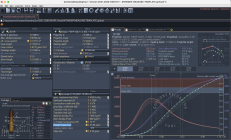I'm a longtime user of QuickLoad, and it's my most-used shooting software, so I probably have a bit of bias towards it. We have a powerful tendency to prefer those things we are familiar with.
I've spent much less time with Gordons Reloading Tool, but am very glad it's out there. Fingers-crossed that the small team supporting it continues to keep it going, now that Gordon has passed.
Neither gives much love to us Mac users. And the user interface of both leaves something to be desired (GRT is visually very busy, and QL is rather dated), IMO. But that's a minor nit.
Much more important is how accurate they are at modeling a load. They both can be very close to real world results. And they both can be off enough to make you shake your head. At the end of the day, they are modeling tools, with emphasis on
model.
Both require a quality chronograph before they can be considered a serious tool for load development.
A couple quick examples of how they compare...
In .308 Win, the Federal Gold Medal Match factory round, using a Sierra 168gr Match King, is fairly well known. Many of us have put together a handload proxy for it.
Here's a print from QL, with case capacity updated to reflect the actual volume in my lot of Lapua brass...

Here's the corresponding print from GRT, with those same parameter tweaks...

They're only two-tenths of a grain apart on load density. They both essentially got that right. But whereas QL predicted velocity and pressure of 2588 fps and 54089 psi, GRT returned 2452 fps and 58290 psi. The last three rounds of Federal 168gr GMM I chrono'd (LabRadar) came in at 2594, 2592, and 2594.
Although QL was much closer on that comparison, it's important to remember that these are simply modeling tools, and in both cases one can make adjustments to burning rate and other parameters in order to bring them more in line with the real world. QL does not always hit so close as it did in this example.
A challenge they both face is getting the information for their databases to begin with. Especially powders.
With H4198 missing in action for what now seems like forever, last year I began to contemplate alternatives. One of the powders I was most interested in was Accurate's LT-30. Alas, QL did not have it (or, LT-32, its older brother) in its database. And I wanted to model it before I did anything else.
Corresponding with Renee Deeter, the North American technical rep for QuickLoad, Renee explained that they were at the mercy of the powder companies. Some were willing to provide the characteristics of their powders. Some weren't.
I then wrote to the folks at Accurate/Ramshot, asking if they would provide the details on LT-30 and LT-32, so QuickLoad could incorporate it in their database. One of their technical folks got back to me with a terse response that that information was considered proprietary.
It was then that I decided to reverse engineer LT-30 and LT-32, so I could include them in my personal copy of QL.
One of the potential strengths of GRT is that it solicits and receives actual field data from its users, and is able to leverage that information to "reverse engineer" powders that the manufacturers have failed to provide data on - like my little go-round with LT-30 and LT-32. Alas, that comes with a very large caveat... how good is that "reverse engineering?" How much can you depend on it?
Here is a print of QL, in .30 BR, using LT-30, incorporating the reverse-engineered parameters I came up with some months ago...

And here is the corresponding print from GRT, using the parameters that they reverse-engineered and incorporated into their database...

To keep things apples-to-apples, I did not include the (fairly minor) burning rate tweak I subsequently made in QL - something I do with nearly all powders to align them with specific powder lot performance - but used the Ba that was incorporated in my initial reverse engineering.
QL predicted 2936 fps and 55986 psi, a result very close to real world results (actual velocity with this load is around 2950). GRT predicted 2782 fps and 38212 psi. A pretty big miss. And just as concerning is the 93.3% load density that GRT says is there. Quite wrong.
I'll note that if you plug in 34.0/H4198 - a powder and charge level familiar to many short-range Benchresters - GRT acquits itself much better.
I'm sure there are examples where GRT did a better job of screening and incorporating user feedback. But crowd sourcing inevitably carries with it the very large question of credibility and quality.
Anyway, internal ballistics has been a black box for too many, for too long. I'm glad we have these two options to help us peer into that mysterious wonderland.














